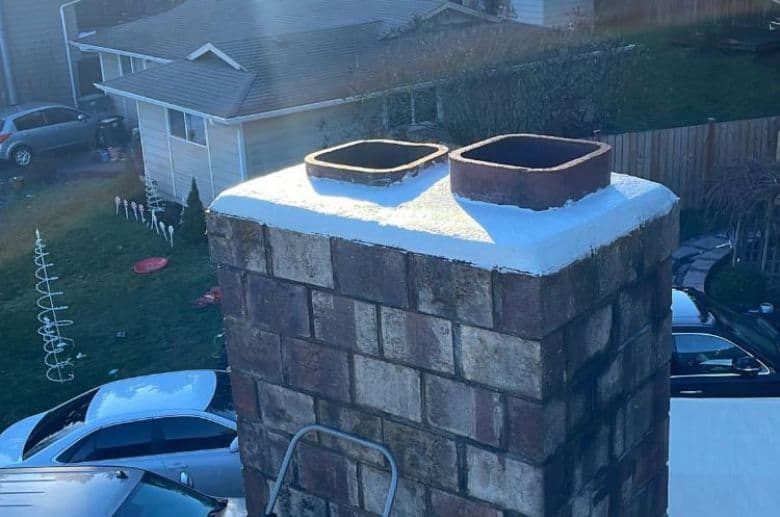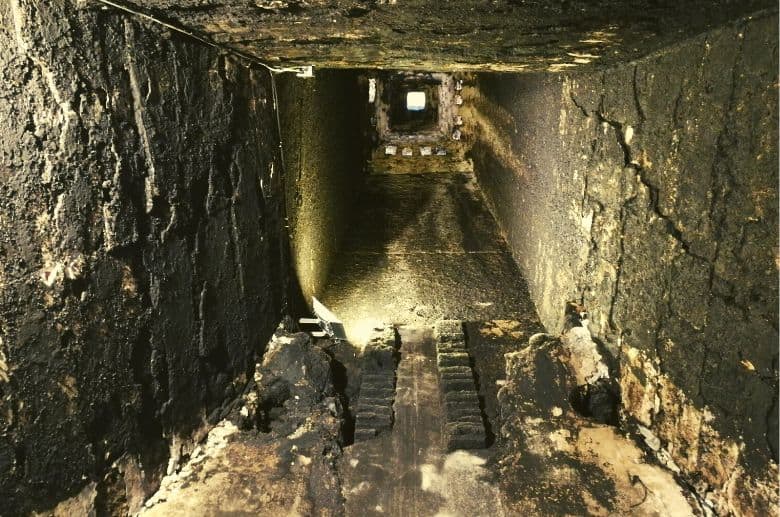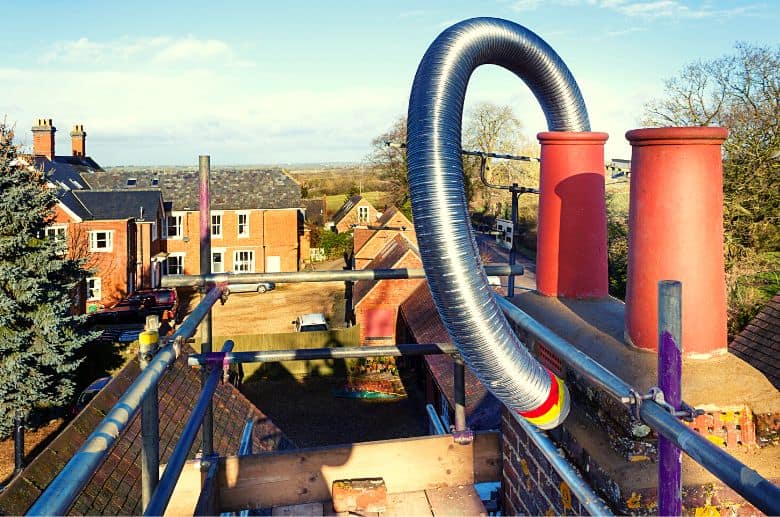Chimneys are an essential part of any home with a fireplace. They aid in venting smoke and other combustion by-products from your home. However, some homeowners wonder if an unlined chimney is safe. A crucial step towards ensuring this safety is choosing the right chimney liner, which can significantly affect the chimney’s efficiency and lifespan.
There are many factors to consider when determining whether is an unlined chimney safe, These include the type of fuel burnt, the chimney’s age, and frequency of use.
The best way to determine this is to have it inspected by a certified chimney professional. They can assess the condition of the chimney and make recommendations about whether or not it needs a liner.
Our guide focuses on the safety of unlined chimneys. We’ll discuss the potential risks and what you can do to keep your family safe if you have an unlined chimney.
What is an Unlined Chimney Flue?

An unlined chimney flue is a chimney that doesn’t have a flue liner. Liners protect the inside parts of a chimney from damage caused by heat and combustion. Without a liner, the chimney is susceptible to cracks and other damage that can lead to leaks and even collapse.
Unlined chimneys are more common in older homes, but you can find them in any home. If you’re not sure whether your chimney is lined or not, you can contact a professional to have it inspected.
You should keep a few things in mind if you have an unlined chimney.
- First, ensure that your chimney is inspected and cleaned regularly, which can help prevent any damage.
- Second, if you experience any damage to your unlined chimney, it’s essential to have it repaired as soon as possible. If left unchecked, damage to an unlined chimney can lead to severe problems, including toxic gas poisoning.
So, while you might use an unlined chimney without any issues, it’s essential to be aware of the potential risks. This is why we recommend having your chimney inspected and lined if possible.
——
Do You Need to Hire Chimney & Fireplace Expert?
Get free quotes from qualified experts near you. No commitment required!
——
Is an Unlined Chimney Safe? What You Need to Know

Identifying whether you have a lined or unlined chimney is crucial because it will help you determine if your chimney is safe to use. If your chimney is unlined, it may be time to consider having it relined.
There are a few ways you can tell if your chimney is lined:
- Visually inspect the chimney flue. If you see a smooth, hard surface, your chimney is likely lined. If you see a rough or crumbly surface, your chimney is probably unlined.
- Additionally, you can look at the outside of your chimney. If the bricks are in good condition and there is no sign of deterioration, your chimney is probably lined. However, if the bricks are crumbling or there is significant damage, your chimney is likely unlined.
- The best way to determine if your chimney is lined is to have it inspected by a professional. A professional will be able to tell you definitively whether your chimney is lined or not.
These problems can be dangerous and potentially lead to a fire. Therefore, ensuring that your chimney is lined and in good condition is vital.
Lined Vs. Unlined Chimneys
Differentiating between lined and unlined chimneys is essential for a few reasons. The most obvious reason is that it will either allow or restrict the type of heating appliance that you can use.
There are a few other key differences between the two types of chimneys.
Performance
Chimney liners help to increase the draw of your fire, which makes your appliance more efficient. They also protect the masonry from the corrosive gases and moisture produced by your fire.
Unlined chimneys do not provide these benefits, and as a result, they are less efficient. In addition, unlined chimneys are more likely to develop problems such as flue gas condensation, which can lead to staining and deterioration of the masonry.
Safety
Chimney liners also improve safety by containing sparks or hot embers that may escape your chimney and fireplace. Homes with unlined chimneys do not provide this level of protection, so there is a greater risk of them catching chimney fires.
Therefore, homeowners currently using an unlined chimney should consider installing a liner. Because they bear more significant risks, unlined chimneys are also more expensive to insure.
——
Do You Need to Hire Chimney & Fireplace Expert?
Get free quotes from qualified experts near you. No commitment required!
——
The Difference in Benefits
Installing a lined chimney offers several benefits that make it worth the investment. Not only will it improve the efficiency of your appliance, but it will also make your home safer. In addition, you may get a discount on your homeowner’s insurance premium.
When choosing between a lined and unlined chimney, the decision is clear. Lined chimneys offer more benefits and are safer; therefore, they should be the preferred choice for most homeowners.
Types of Chimney Liners
When comparing chimney liner materials, each have there own benefits and drawbacks that you’ll need to consider.
Metal Liners

Metal is the most common type of liner found in today’s homes, and it’s also the most versatile, as you can use it in masonry and prefabricated fireplaces. Different types of metal liners are available, including stainless steel, aluminum, and cast-in-place.
- Stainless Steel: If you are using gas, oil, or wood-burning appliances, stainless steel is the best type of liner to use, and it’s also the most expensive option. It can last 15-20 years without issues if it’s a good-quality liner.
- Aluminum: For medium-efficiency appliances, such as fireplaces, aluminum is a good choice. It’s not as durable as stainless steel, so that it won’t last as long. However, it’s less expensive and efficient if you only use your fireplace occasionally or on a budget.
Clay Chimney Liner

Because clay is a natural material, it’s an excellent conductor of heat. Clay chimney liners are typically used in masonry fireplaces and provide good insulation.
The most notable benefit of using clay chimney liners is their lifespan; with proper care, they can easily last over 50 years. But this is only possible if installed correctly, as even a tiny crack can cause the liner to fail.
Cast-In-Place Chimney Liner
Unlike other types of liners, cast-in-place doesn’t come in prefabricated sections. They’re made of a cement-like mixture that’s poured down the flue to form a single continuous, single-piece flue liner.
While they aren’t the cheapest relining solution, they are undoubtedly effective, and like clay chimney liners, cast-in-place liners can last up to 50 years with proper maintenance.
Chimney Relining Cost
Relining your chimney is a great way to improve its function and safety and extend its lifespan. It might not be cheap, but when we consider the risks involved in not relining a chimney, the price is nothing in comparison.
The average cost to reline a chimney will depend on the type of relining system used, the size and shape of your chimney, and whether any repairs are needed before the relining can be installed.
| Type of Chimney Liner | Average Installation Cost (Per Foot) |
| Aluminum | $5 to $20 without including labor |
| Stainless steel | $20 to $40, not including labor |
| Cast-in-place liners | From $25 to $250 for materials only |
| Ceramic liners | From $50 to $200 without including labor |
| Clay liners | $6 to $15 for materials only |
Conclusion
Using a chimney without a liner is dangerous and could put your family at risk. On the other hand, relining your chimney will improve its efficiency and extend its lifespan.
If you’re thinking about relining your chimney, get in touch with a qualified professional to get an accurate quote for the work.
Not only is it essential to know the cost upfront, but having a professional install your relining system will ensure that it’s done correctly and safely.
FAQs
Can I burn wood in an unlined chimney?
You can burn wood in an unlined chimney, but it’s not recommended. This is because you’ll be putting your family and home at risk. Burning wood in an unlined chimney can cause creosote to build up, and if this catches fire, it could spread quickly through your home.
Additionally, the searing heat, piercing smoke, and burning embers can be a recipe for starting a roof fire with temperatures reaching over 1,200°F.
Can you put a new liner in an old chimney?
Installing a new liner in an old chimney is possible, but it’s not always necessary. If your chimney is in good condition and has no structural damage, you may not need to replace the liner.
However, if there are cracks or gaps in the mortar joints or the bricks are beginning to crumble, you will need to have the chimney relined.






